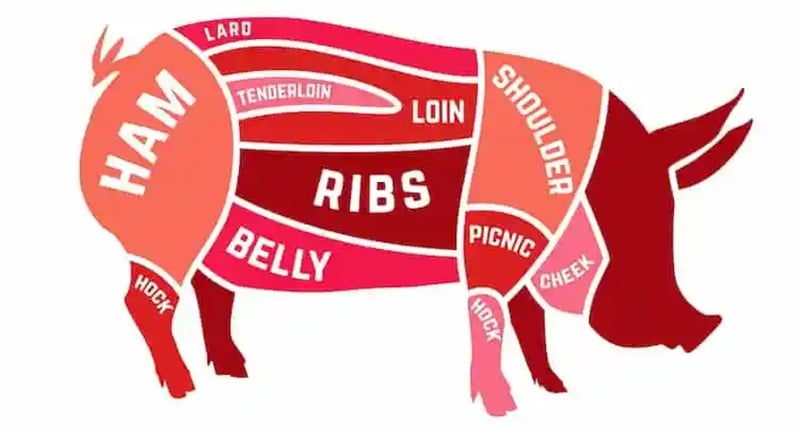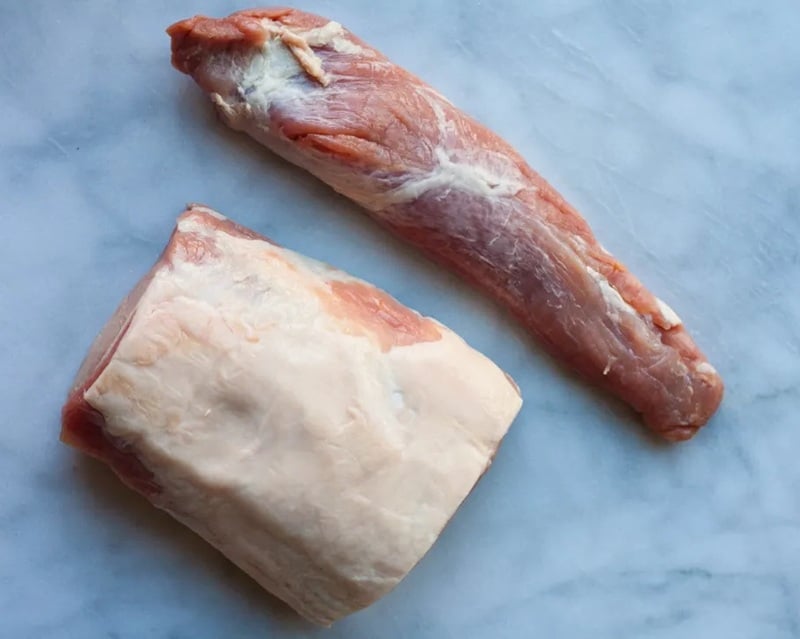Pork loin and pork tenderloin might sound like the same thing, but they’re completely different cuts of meat. They come from different parts of the pig, they cook differently, and if you mix them up, you could end up with dry, overcooked pork or the wrong texture for your recipe.
Pork Loin vs Pork Tenderloin: Quick Comparison
| Feature | Pork Loin | Pork Tenderloin |
|---|---|---|
| Cut Location | From the back, near the spine | From the muscle that runs along the backbone |
| Shape & Size | Wide, thick, and can be bone-in or boneless | Long, narrow, always boneless |
| Texture | Firm but tender with a fat cap | Very lean and soft with little fat |
| Flavor | Rich, meaty, can handle marinades and rubs. | Mild, delicate, takes on flavors easily |
| Best Cooking Methods | Roasting, grilling, smoking | Quick roasting, grilling, pan-searing |
| Cook Time | Longer (due to size and thickness) | Short (cooks fast, can dry out quickly) |
| Substitutable? | Not really — they cook differently | Only with major adjustments |
| Common Weight | 2 to 6 pounds | 1 to 1.5 pounds |
I’ve cooked plenty of both over the years, and in this guide, I’ll break it down nice and simple — what each cut is, how to tell them apart, and when to use one over the other. Let’s clear it up once and for all.
Where Pork Loin and Tenderloin Come From on the Pig

What Is Pork Loin?
Pork loin is a large, wide cut of meat that comes from the back of the pig, running along the spine between the shoulder and the beginning of the leg.
It’s sometimes called a “center-cut pork roast,” and depending on how it’s butchered, it can be sold bone-in or boneless.
This cut is thick and fairly uniform in shape. It comes with a nice fat cap on one side that adds flavor and helps keep it juicy during cooking.
It’s firmer than pork tenderloin but still tender when cooked right.
Pork loin does best with low and slow cooking. It’s perfect for roasting in the oven, grilling over indirect heat, or smoking at a steady temperature.
Want to master low-and-slow cooking? My Smoking Basics hub breaks it all down, from fire control to smoke flavor.
I also like to slice it into thick pork chops, stuff it, or rub it down and cook it whole. Just avoid high heat from start to finish, or it will dry out the outside before the inside is done.
Eddie’s Tip! When I cook pork loin on the smoker, I keep the temp around 225–250°F and pull it at 145°F internal. Let it rest, slice it thick.
What Is Pork Tenderloin?
Pork tenderloin is a small, narrow, and very lean cut of meat that comes from a muscle running along the pig’s backbone, just underneath the loin. It’s one of the most tender parts of the entire animal.
This cut is always boneless and typically weighs around 1 to 1.5 pounds. It’s shaped like a long, thin cylinder, much smaller than a pork loin and without the fat cap. Because it’s so lean, it cooks quickly and needs to be watched closely to avoid drying out.
If you’re new to grilling or want to sharpen your skills, check out my Grilling Basics guide for tips, gear, and techniques.
Pork tenderloin has a mild flavor and soft, buttery texture, making it a great match for marinades, rubs, and sauces. It’s perfect for quick-cooking methods like pan-searing, roasting, or grilling over medium heat. You don’t need to cook it low and slow — just hot and fast, and don’t forget to rest it before slicing.
Here’s one of my pork tenderloin recipes if you want to see exactly how I cook it for juicy, flavorful results every time.
Eddie’s Tip! I like to give pork tenderloin a good sear on all sides, then finish it at 375°F over indirect heat on the grill. Pull it at 145°F, let it rest 5–10 minutes.
Visual Comparison of the pork tenderloin and the pork loin.

Key Differences Between Pork Loin and Tenderloin
Even though pork loin and pork tenderloin sound similar, they’re very different cuts, and knowing those differences can save you from a dry, overcooked dinner.
Cut and Size
Pork loin is wide, thick, and often sold in larger pieces — perfect for slicing into chops or cooking as a roast. Tenderloin is long, narrow, and much smaller in size. It looks more like a small log than a roast.
Texture and Fat Content
- Pork loin has a firmer bite and usually comes with a fat cap, which helps keep it juicy.
- Tenderloin is very lean and super soft — it’s the most tender part of the pig, but dries out fast if you’re not careful.
Pork Loin vs Tenderloin Taste
- Pork loin has a richer, meatier flavor, especially when cooked with the fat cap on or smoked low and slow.
- Tenderloin has a milder taste but takes on marinades and seasonings really well.
Cooking Method
- Pork loin likes low and slow. Roasting, smoking, or indirect grilling. It needs time for the inside to cook without drying out the outside.
- Pork tenderloin is best with hot and fast. Sear it, roast it, or grill it over medium heat. It’s done in about 20–30 minutes.
Price and Portions
- Pork tenderloin is usually more expensive per pound because it’s smaller and more tender.
- Pork loin is more affordable and great when you’re cooking for a group.
Can You Swap One for the Other?
Pork loin and pork tenderloin are not good substitutes for each other in most recipes, and here’s why.
Pork loin is much larger, thicker, and has a fat cap that allows it to cook low and slow without drying out.
Pork tenderloin, on the other hand, is small, lean, and cooks fast.
If you tried to use tenderloin in a pork loin recipe, it would likely dry out before it ever cooks through properly.
And if you used pork loin in a recipe meant for tenderloin, the middle might still be raw while the outside is overcooked.
There are some exceptions, as always, but they take a little work. You might slice pork loin into thinner chops to speed up cook time, or butterfly it to mimic the thickness of a tenderloin. Just know that the texture and flavor will still be different, and you’ll have to adjust temperatures and times.
Eddie’s Tip! If a recipe calls for one, stick with it. These cuts may come from the same general area on the pig, but they’re not interchangeable, and your dinner guests will know the difference.
Which One Should You Choose?
The right cut depends on what you’re cooking and how much time you’ve got.
When To Choose Pork Loin?
If you’re cooking for a group, want leftovers, or feel like firing up the smoker or grill for a longer cook, pork loin is the way to go.
It’s more forgiving, can handle a good rub, and stays juicy with that fat cap if you treat it right.
When To Choose Pork Tenderloin
On the other hand, if you’re looking for something quick and easy to get on the table during the week, pork tenderloin is your friend. It cooks fast, takes on marinades well, and doesn’t need a lot of fuss.
Both are delicious when cooked properly. You don’t have to pick a favorite — just pick the right one for the job.
Eddie’s Tip! I like to keep one of each in the freezer. Tenderloin is perfect for a last-minute meal, and pork loin is great when I’ve got time to smoke something that’ll impress the neighbors.
Pork Loin vs Tenderloin – My Experience
I’ve cooked both of these cuts more times than I can count, on the grill and the smoker. Pork loin is my go-to when I am having family or friends over, or want something that can take a good dry rub and a long smoke.
Pork tenderloin, on the other hand, is perfect for quick meals for just my wife and me. It’s lean and cooks fast, but you’ve got to watch it like a hawk.
I like to marinate it or season it simply and get a good sear before finishing it off over indirect heat on the grill.
Bottom line: both cuts have their place, but knowing the difference will save you from a ruined dinner or a dry piece of meat. Once you know what you’re working with, it’s easy to get great results every time.
If you’re looking for inspiration, check out all my pork recipes here — from juicy tenderloins to smoked pork loin, pulled pork, chops, and more.
FAQs
Q: What’s more tender, pork loin or pork tenderloin?
A: Pork tenderloin is the most tender cut of pork because it comes from a muscle that doesn’t get much exercise. Pork loin is tender too, but has a bit more firmness and a fat cap, which adds flavor but makes it slightly less tender.
Q: Can I use pork loin instead of tenderloin in a recipe?
A: Generally, NO. Pork loin is larger and thicker, that needs longer cooking times at a lower heat to stay juicy. Tenderloin cooks quickly and can dry out if overcooked. If you swap them, you’ll need to adjust cooking times and methods carefully.
Q: Which cut is healthier, pork loin or pork tenderloin?
A: Pork tenderloin is leaner and lower in fat, making it the healthier choice if you’re watching calories or fat intake. Pork loin has a bit more fat, especially if it includes the fat cap, which can add flavor but also calories.
Q: How can I tell pork loin and tenderloin apart at the store?
A: Look at the size and shape: pork loin is wide, thick, and can be bone-in or boneless. Tenderloin is small, long, thin, and always boneless. The tenderloin will look more like a narrow cylinder, while the loin is flatter and broader.
Q: What’s the best way to cook pork tenderloin to keep it juicy?
A: Cook pork tenderloin quickly over medium-high heat to sear the outside, then finish in the oven or grill over indirect heat. Pull it off the heat at 145°F internal temperature and let it rest for a few minutes. Avoid overcooking to prevent dryness.
Q: Can pork loin be cooked on a smoker?
A: Yes! Pork loin is excellent for smoking because its size and fat cap help keep it moist during low-and-slow cooking. Just maintain a low temperature and use a good rub or marinade for the best flavor.
More Pork Tips & Recipes You Might Like
Eddie van Aken
Eddie van Aken brings years of experience from running a full-service restaurant, where he honed his skills with all types of kitchen equipment. His expertise extends to mastering the art of outdoor cooking, utilizing the right recipes to enhance flavors on grills and smokers. Eddie’s in-depth knowledge allows him to provide comprehensive grill reviews and valuable outdoor cooking tips, helping enthusiasts make the most of their grilling adventures. You can read more on the About page for Eddie van Aken
